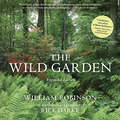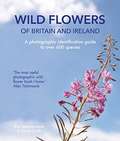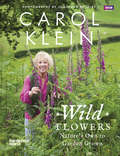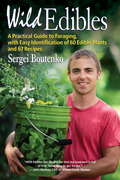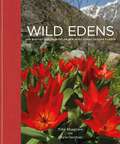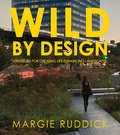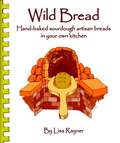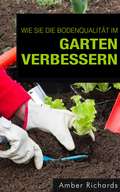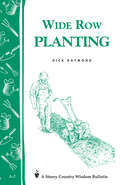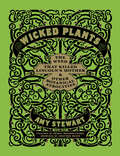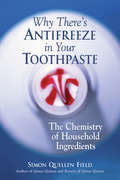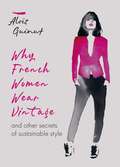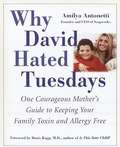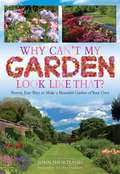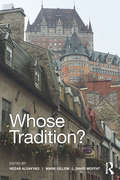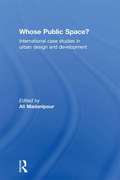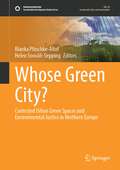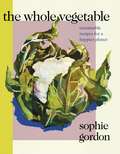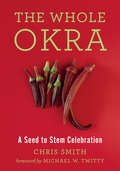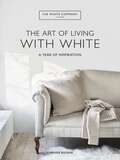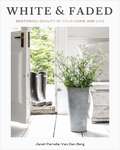- Table View
- List View
The Wild Garden: Expanded Edition
by William Robinson Rick DarkeFirst published in 1870, The Wild Garden challenged the prevailing garden style of the day and advocated a naturalistic style, in which hardy plants, both native and exotic, are arranged in groupings that mimic wild landscapes. Thanks to Robinson’s passionate advocacy, the naturalistic style triumphed, and Robinson's urgent message continues to resonate today. For this newly designed edition, Rick Darke has written an introductory essay that not only underscores Robinson’s importance in the evolution of garden design and ecology, but also explains his relevance for today’s gardeners, designers, and landscape professionals. The book contains over 100 stunning photographs taken by Darke, including images of Gravetye and of modern “wild” gardens.
Wild Flowers of Britain and Ireland
by Rae Spencer Jones Sarah CuttleThe close-up photographs allow you to examine each plant in detail - so you will know your English from your Spanish bluebell - and because it is done by colour instead of name, it is much easier to navigate.Full of fascinating information, including where and when you will find the flowers, their characteristics, and anecdotes on their historical background with their medicinal and culinary uses. You don't even need to go out into the field to enjoy these beautiful and sometimes elusive flowers.
Wild Flowers: Nature's own to garden grown
by Carol KleinWild flowers are a great passion for Carol, and for the TV show this year she’s travelling the length and breadth of the country to find the most exquisite flora occurring naturally in our woodlands, hedgerows, meadows and moors, and then she sets off in search of their cultivated cousins, and shows us how to grow them in our own gardens. In her accompanying book, Carol delves into the story of each plant, full of myth, legend and country lore, and as always shares her practical expertise, passing on hints and tips, including which variations to go for, how and where to plant, and what with, for the most spectacular results.Containing thirty two of Britain's favourite wild flowers and their home-grown descendents, structured by season and illustrated with Jonathan Buckley’s amazing photographs, this book of botanical wonders will inspire, surprise and inform gardeners of all levels.
Wild Edibles
by Sergei BoutenkoIn this field guide to foraging wild edible plants, Sergei Boutenko (son of raw-food guru Victoria Boutenko) explores the health benefits of wild-harvested food, explains how to safely identify trailside weeds, herbs, fruits, and greens that grow worldwide, and shares his delicious, nutrient-dense recipes.Sergei Boutenko has been gathering wild plants since he was 13, when, early on in a 6-month hike from Mexico to Canada, he and his raw-food family ran out of provisions and turned to foraging for survival in the wild. Back in civilization, Boutenko was dismayed by the inferior quality of store-bought food and industrial agriculture, and began to regularly collect wild plants near his home and on his travels. Now, in Wild Edibles, he shares knowledge gleaned from years of live-food wildcrafting and thriving in harmony with nature.This practical guide to plant foraging gives hikers, backpackers, raw foodists, gardeners, chefs, foodies, DIYers, survivalists, and off-the-grid enthusiasts the tools to identify, harvest, and prepare wild edible plants. The book outlines basic rules for safe wild-food foraging and discusses poisonous plants, plant identification protocol, gathering etiquette, and conservation.Boutenko explores in detail the many rewards of eating wild flora: environmental protection, sustainability, saving money, economic self-sufficiency, and healthy living. He draws on thoroughly researched nutrition science to make a compelling case for the health benefits of a diverse, local-food diet that includes wild greens.The majority of the 60 edible plants described in this field guide can be found worldwide, including common-growing trees. Over 300 color photos make plant identification easy and safe. A chapter containing 67 high-nutrient vegan recipes--including green smoothies, salads and salad dressings, spreads and crackers, main courses, juices, and sweets--provides inspiration to join Sergei on the trail to radiant health."Wild Edibles: A Practical Guide to Foraging, with Easy Identification of 60 Edible Plants and 67 Recipes has taught me that my backyard is full of free food! Way to go, Sergei." --John Mackey, CEO of Whole Foods MarketFrom the Trade Paperback edition.
Wild Edens
by Chris Gardner Toby MusgraveOrnamental plants are the cornerstone of our gardens and we are spoiled for choice with literally tens of thousands of hardy beauties from which to select. But we take them absolutely for granted, not for a moment realising that every plant has a fascinating tale to tell. Wild Edens sets the record straight. With global coverage, each of the nine richly illustrated chapters explores a plant biodiversity hotspot. The reader is transported on a visually stunning and fascinating voyage of discovery which reveals our garden favourites - as well as some species that should be more widely cultivated - in their natural habitats, from daffodils from Andalusia and tulips from the Tien Shan, to monkey puzzles from Chile and rhododendrons from the Himalayas, lilies from Japan and proteas from South Africa.Because the authors have been to the hotspots, each chapter opens with their personal reflections on the landscape and spirit of place, and closes with their selection of prime locations. In between, the informative yet approachable text tells of the plants' 'forgotten stories'. Of the landscapes which are their home, the adventures of how and when they were discovered and by whom, the reasons why they were collected, their impact on garden fashions and trends, etc. Wild Edens brings another dimension of interest and understanding to plants and gardens, as well as being a premium armchair traveller's guide to the natural world of garden plants.
Wild By Design: Strategies for Creating Life-Enhancing Landscapes
by Margie RuddickCan nature--in all its unruly wildness--be an integral part of creative landscape design? In her beautifully illustrated book, Wild by Design, award-winning designer Margie Ruddick urges designers to look beyond the rules often imposed by both landscaping convention and sustainability checklists. Instead, she offers a set of principles for a more creative and intuitive approach that challenges the entrenched belief that natural processes cannot complement high-level landscape design.Wild by Design defines and explains the five fundamental strategies Ruddick employs, often in combination, to give life, beauty, and meaning to landscapes: Reinvention, Restoration, Conservation, Regeneration, and Expression. Drawing on her own projects--from New York City's Queens Plaza, formerly a concrete jungle of traffic, to a desertscape backyard in Baja, California, to the Living Water Park in Chengdu, China--she offers guidance on creating beautiful, healthy landscapes that successfully reconnect people with larger natural systems.A revealing look into the approach of one of sustainable landscape design's most innovative practitioners, Wild by Design stretches the boundaries of landscape design, offering readers a set of broader, more flexible strategies and practical examples that allow for the unexpected exuberance of nature to be a welcome part of our gardens, parks, backyards, and cities.
Wild Bread: Hand-Baked Sourdough Artisan Breads in Your Own Kitchen
by Lisa RaynerThis book explores what goes on inside dough as it is transformed from water, flour, wild yeast and probiotic bacteria into the kind of bread that makes your mouth water. You may never be satisfied with ordinary bread again. Once you learn what factors affect aroma, flavor, shape, crust and crumb, you too will be transformed into an artisan. Wild Bread encourages your creativity and provides the basic principles you need to bake any bread you desire without needing a recipe. Wild Bread teaches you how to make authentic whole grain sourdough artisan breads that are easy to knead by hand and make in the variable temperatures and humidities of an ordinary kitchen.
Wie Sie die Bodenqualität im Garten verbessern
by Amber RichardsBringen Sie Ihren Garten in Schwung: mit einem gesunden Boden und auf ganz natürliche Weise! Mit diesem einfach zu befolgenden Ratgeber erhalten Sie köstliche Früchte, gesundes Gemüse, herrlich duftende Blumen und kräftige Kräuter. Niemals würden Sie ein Haus auf einem morschen Fundament errichten. – Wieso sich also mit schlechter Erde im Garten abgeben, wo alle Pflanzen vor sich hin kümmern? Egal, ob Sie einen grünen Daumen haben, mit „Wie Sie die Bodenqualität im Garten verbessern“ verpassen Sie Ihrem Garten auf mühelose Weise eine Verjüngungskur. Er wird nicht nur vor gesunden Pflanzen strotzen, sondern auch Vögel werden sich dort wohlfühlen. Nach den ersten Erfolgen fragen Sie sich dann ganz bestimmt, wieso Sie nicht schon viel früher gehandelt haben! Mit diesem Buch lernen Sie, wie man den Nährstoffgehalt des Bodens erhöht, die Bodenstruktur verbessert und die Widerstandskräfte des Gartens in praktisch jedem Klima weckt. Dank der in diesem Buch wunderbar beschriebenen natürlichen Methoden können Sie endlich stolz auf Ihren Garten sein und sich zu jeder Jahreszeit an einer gesunden und köstlichen Ernte erfreuen. Warten Sie nicht länger, sondern verwandeln Sie mithilfe dieses Ratgebers Ihren Garten in eine üppige, fruchtbare und gesunde Oase, in der Ihre Pflanzen gedeihen können.
Wide Row Planting: Storey's Country Wisdom Bulletin A-02
by Dick RaymondSince 1973, Storey's Country Wisdom Bulletins have offered practical, hands-on instructions designed to help readers master dozens of country living skills quickly and easily. There are now more than 170 titles in this series, and their remarkable popularity reflects the common desire of country and city dwellers alike to cultivate personal independence in everyday life.
Wicked Plants: The Weed That Killed Lincoln's Mother and Other Botanical Atrocities
by Amy Stewart Briony Morrow-Cribbs Jonathon RosenA tree that sheds poison daggers; a glistening red seed that stops the heart; a shrub that causes paralysis; a vine that strangles; and a leaf that triggered a war. In Wicked Plants, Stewart takes on over two hundred of Mother Nature’s most appalling creations. It’s an A to Z of plants that kill, maim, intoxicate, and otherwise offend. You’ll learn which plants to avoid (like exploding shrubs), which plants make themselves exceedingly unwelcome (like the vine that ate the South), and which ones have been killing for centuries (like the weed that killed Abraham Lincoln's mother). Menacing botanical illustrations and splendidly ghastly drawings create a fascinating portrait of the evildoers that may be lurking in your own backyard. Drawing on history, medicine, science, and legend, this compendium of bloodcurdling botany will entertain, alarm, and enlighten even the most intrepid gardeners and nature lovers.
Why There's Antifreeze in Your Toothpaste: The Chemistry of Household Ingredients
by Simon Quellen FieldA Selection of the Scientific American Book ClubExplaining why antifreeze is a component of toothpaste and how salt works in shampoo, this fascinating handbook delves into the chemistry of everyday household products. Decoding more than 150 cryptic ingredients, the guide explains each component's structural formula, offers synonymous names, and describes its common uses. This informative resource can serve curious readers as a basic primer to commercial chemistry or as an indexed reference for specific compounds found on a product label. Grouped according to type, these chemical descriptions will dissolve common misunderstandings and help make consumers more product savvy.
Why French Women Wear Vintage: and other secrets of sustainable style
by Aloïs Guinut"The sustainable fashion revolution has begun, and we must all be part of it." - Aloïs GuinutStylish women everywhere are realizing the environmental damage of fast fashion and looking for new ways to dress that don't involve cramming their wardrobe with clothes that may never get worn. As Paris-based style-coach Aloïs Guinut explores in this invaluable book, French women have a lot to teach us about how to cherish the planet without sacrificing your style:- Know what works for you.- Buy less and buy better.- Mix vintage items with a few wisely chosen modern pieces.- Optimize your closet.- Look after what you have and make it last.- Seek out quality fabrics that don't poison the environment.
Why French Women Wear Vintage: and other secrets of sustainable style
by Aloïs Guinut"The sustainable fashion revolution has begun, and we must all be part of it." - Aloïs GuinutStylish women everywhere are realizing the environmental damage of fast fashion and looking for new ways to dress that don't involve cramming their wardrobe with clothes that may never get worn. As Paris-based style-coach Aloïs Guinut explores in this invaluable book, French women have a lot to teach us about how to cherish the planet without sacrificing your style:- Know what works for you.- Buy less and buy better.- Mix vintage items with a few wisely chosen modern pieces.- Optimize your closet.- Look after what you have and make it last.- Seek out quality fabrics that don't poison the environment.
Why David Hated Tuesdays: One Courageous Mother's Guide to Keeping Your Family Toxin and Allergy Free
by Amilya AntonettiUsing the information she has gathered over years of developing natural cleaning products, Amilya guides readers through a typical house,room by room, explaining how you can keep your own home clean without using heavy chemicals. She offers recipes for making your ownproducts to clean windows, wash clothes, and furniture. In addition, she offers a tour of all of the chemicals in your house that might bemaking you or your family sick-including paint, carpet, and mold-and how to take control of the situation. Chapters include:* Choosing to Know* Better Choices Throughout the Home* Better Choices in the Kitchen* Better Choices in the Bathroom. . . and so on throughout the house, as readers learn which ordinary products might be bothering them and how to pick safe alternatives.
Why Can't My Garden Look Like That?: Proven, Easy Ways To Make A Beautiful Garden Of Your Own
by John ShortlandHow many times when we are visiting gardens, or thumbing through a glossy magazine, do we look at our own garden with mixed feelings of disappointment and despair, and exclaim 'Why can`t my garden look like that?'. The simple answer is `it can`. This book demonstrates just how easy it is to make adjustments to what is already there to make your garden stunning, whatever its size. Whether it's an issue with design, plant selection or pruning - or even lack of time - simple solutions are described in clear, jargon-free language that will appeal both to the complete novice and those with more experience. Written in an informal, easy-to-read style this book will enable everyone to have a garden they can be proud of.
Whose Tradition?: Discourses on the Built Environment
by Nezar AlSayyad Mark Gillem David MoffatIn seeking to answer the question Whose Tradition? this book pursues four themes: Place: Whose Nation, Whose City?; People: Whose Indigeneity?; Colonialism: Whose Architecture?; and Time: Whose Identity?Following Nezar AlSayyad’s Prologue, contributors addressing the first theme take examples from Indonesia, Myanmar and Brazil to explore how traditions rooted in a particular place can be claimed by various groups whose purposes may be at odds with one another. With examples from Hong Kong, a Santal village in eastern India and the city of Kuala Lumpur, contributors investigate the concept of indigeneity, the second theme, and its changing meaning in an increasingly globalized milieu from colonial to post-colonial times. Contributors to the third theme examine the lingering effects of colonial rule in altering present-day narratives of architectural identity, taking examples from Guam, Brazil, and Portugal and its former colony, Mozambique. Addressing the final theme, contributors take examples from Africa and the United States to demonstrate how traditions construct identities, and in turn how identities inform the interpretation and manipulation of tradition within contexts of socio-cultural transformation in which such identities are in flux and even threatened. The book ends with two reflective pieces: the first drawing a comparison between a sense of ‘home’ and a sense of tradition; the second emphasizing how the very concept of a tradition is an attempt to pin down something that is inherently in flux.
Whose Public Space?: International Case Studies in Urban Design and Development
by Ali MadanipourPublic spaces mirror the complexities of urban societies: as historic social bonds have weakened and cities have become collections of individuals public open spaces have also changed from being embedded in the social fabric of the city to being a part of more impersonal and fragmented urban environments. Can making public spaces help overcome this fragmentation, where accessible spaces are created through inclusive processes? This book offers some answers to this question through analysing the process of urban design and development in international case studies, in which the changing character, level of accessibility, and the tensions of making public spaces are explored. The book uses a coherent theoretical outlook to investigate a series of case studies, crossing the cultural divides to examine the similarities and differences of public space in different urban contexts, and its critical analysis of the process of development, management and use of public space, with all its tensions and conflicts. While each case study investigates the specificities of a particular city, the book outlines some general themes in global urban processes. It shows how public spaces are a key theme in urban design and development everywhere, how they are appreciated and used by the people of these cities, but also being contested by and under pressure from different stakeholders.
Whose Green City?: Contested Urban Green Spaces and Environmental Justice in Northern Europe (Sustainable Development Goals Series)
by Bianka Plüschke-Altof Helen Sooväli-SeppingAgainst the backdrop of an accelerating global urbanization and related ecological, climatic or social challenges to urban sustainability, this book focuses on the access to “safe, inclusive and accessible green and public space” as outlined in United Nations’ Sustainable Development Goal No. 11. Looking through the lens of environmental justice and contested urban spaces, it raises the question who ultimately benefits from a green city development, and – even more importantly – who does not. While green space benefits are well-documented, green space provision is faced by multiple challenges in an era of urban neoliberalism. With their interdisciplinary and multi-method approach, the chapters in this book carefully study the different dimensions of green space access with particular focus on vulnerable groups, critically evaluate cases of procedural injustice and, in the case of Northern Europe that is often seen as forerunner of urban sustainability, provide in-depth studies on the contexts of injustices in urban greening. Chapters 1, 5, and 6 are available open access under a Creative Commons Attribution 4.0 International License via link.springer.com.
The Whole Vegetable: Sustainable and delicious vegan recipes
by Sophie GordonDiscover wholesome, sustainable and plant-based dishes in this essential cookbook, perfect for anyone looking to reduce their waste this year!'Hearty, healthy, flavour-packed dishes' MAIL ON SUNDAY'A uniquely sustainable and delicious approach to modern plant-based cooking' VOGUE'The Whole Vegetable blew me away . . . Full of inventive waste-free recipes' Tom Hunt, GUARDIAN_________Have you ever wondered how to make your diet truly eco-conscious?In this beautiful plant-based cookbook, over 130 creative, delicious, planet-friendly recipes put vegetables at the very centre of the table. Embracing often-discarded parts such as leaves, stalks, tops, flowers, seeds and even peelings, this is cooking at its most sustainable.In The Whole Vegetable, Sophie Gordon shows us how to:- Cook with every part of every vegetable- Reduce waste in your cooking- Reinvent your leftovers- Eat with the seasonsFrom Cauliflower Carbonara, Broccoli Pesto and Chunky Pumpkin Tacos, to Cherry Breakfast Crumble, Maple-Roasted Pears and Apple & Walnut Danish Buns, The Whole Vegetable is packed with thoughtful recipes for every season.Most of all, it will ensure that nothing in your kitchen goes to waste._________'Creative, delicious, planet-friendly recipes . . . Teaches you how to put those often discarded parts of fruit and veg to good (and tasty) use' Women's Health'Wow, Sophie Gordon's . . . The Whole Vegetable blew me away. I wonder if she is the next Anna Jones. A seasonal, plant-centric, whole food recipe book without ultra-processed vegan ingredients. The recipes are super-inventive and importantly waste free!' Eco-Chef Tom Hunt'The Whole Vegetable heroes plant-based cookery, with recipes that also help reduce food waste in the kitchen and improve sustainable living. A worthwhile read' Good Housekeeping
The Whole Okra: A Seed To Stem Celebration
by Chris SmithChris Smith’s first encounter with okra was of the worst kind: slimy fried okra at a greasy-spoon diner. Despite that dismal introduction, Smith developed a fascination with okra, and as he researched the plant and began to experiment with it in his own kitchen, he discovered an amazing range of delicious ways to cook and eat it, along with ingenious and surprising ways to process the plant from tip-to-tail: pods, leaves, flowers, seeds, and stalks. Smith talked okra with chefs, food historians, university researchers, farmers, homesteaders, and gardeners. The summation of his experimentation and research comes together in The Whole Okra, a lighthearted but information-rich collection of okra history, lore, recipes, craft projects, growing advice, and more. The Whole Okra includes classic recipes such as fried okra pods as well as unexpected delights including okra seed pancakes and okra flower vodka. Some of the South’s best-known chefs shared okra recipes with Smith: Okra Soup by culinary historian Michael Twitty, Limpin’ Susan by chef BJ Dennis, Bhindi Masala by chef Meherwan Irani, and Okra Fries by chef Vivian Howard. Okra has practical uses beyond the edible, and Smith also researched the history of okra as a fiber crop for making paper and the uses of okra mucilage (slime) as a preservative, a hydrating face mask, and a primary ingredient in herbalist Katrina Blair’s recipe for Okra Marshmallow Delight. The Whole Okra is foremost a foodie’s book, but Smith also provides practical tips and techniques for home and market gardeners. He gives directions for saving seed for replanting, for a breeding project, or for a stockpile of seed for making okra oil, okra flour, okra tempeh, and more. Smith has grown over 75 varieties of okra, and he describes the nuanced differences in flavor, texture, and color; the best-tasting varieties; and his personal favorites. Smith’s wry humor and seed-to-stem enthusiasm for his subject infuse every chapter with just the right mix of fabulous recipes and culinary tips, unique projects, and fun facts about this vagabond vegetable with enormous potential.
Who Knew?: Green Hints and Tips to Save Time, Money... And the Planet
by Jeanne Bossolina LubinWho Knew?: You can save 40% on the cost of air conditioning, that bottled water creates over 1.5 million tons of plastic waste a year, turning off your car's air conditioner can improve your fuel economy by more than 20%... and much more.
The White Company The Art of Living with White: A Year of Inspiration (White Company)
by Chrissie Rucker Company'I love a home to feel warm, inviting, personal and lived-in - and mastering how to decorate with white and neutrals is a wonderful way to achieve this.''- CHRISSIE RUCKERIn her much-anticipated second book, The Art Of Living With White, Chrissie Rucker, Founder of The White Company, explores 10 inspirational homes that illustrate beautifully different ways to use white and neutrals through the seasons. The homes vary in size, style and location - from a minimalist city pied-à-terre to a New England-style country house - but what unites them all is the welcoming, stylish and calm feel that their owners have each created.The homes are grouped into the four seasons and each chapter ends with a summary of seasonal rituals that will work in any home. A concluding chapter - Inspiration & Resources - considers finding your own style, how to create a good balance between work and home in interior spaces, the art of simple entertaining and the importance of scent and touch in a truly comfortable home.
The White Company The Art of Living with White: A Year of Inspiration (White Company)
by Chrissie Rucker CompanyFrom the author of the home decorating bestseller, For the Love of White, comes an inspirational and informative guide to creating a welcoming home through the seasons using a white and neutral palette.'I love a home to feel warm, inviting, personal and lived-in - and mastering how to decorate with white and neutrals is a wonderful way to achieve this.' - CHRISSIE RUCKERIn her much-anticipated second book, The Art Of Living With White, Chrissie Rucker, Founder of The White Company, explores 10 inspirational homes that illustrate beautifully different ways to use white and neutrals through the seasons. The homes vary in size, style and location - from a minimalist city pied-à-terre to a New England-style country house - but what unites them all is the welcoming, stylish and calm feel that their owners have each created.The homes are grouped into the four seasons and each chapter ends with a summary of seasonal rituals that will work in any home. A concluding chapter - Inspiration & Resources - considers finding your own style, how to create a good balance between work and home in interior spaces, the art of simple entertaining and the importance of scent and touch in a truly comfortable home.Praise for The White Company: For the Love of White'A testament to the power of neutrals' - House and Garden'A visual feast with a passion for all things white at its heart' - House Beautiful
White and Faded: Restoring Beauty in Your Home and Life
by Janet Parrella-Van Den BergThe only thing more beautiful than home transformation is personal transformation. Bring new life into your home and your soul through the gorgeous photography, inspiring story, and creative design ideas from Janet Parrella-Van Den Berg, founder of popular UK brand White & Faded. Journey through these hope-filled pages, and discover the hidden beauty in your own home and life.In White & Faded, Janet Parrella-Van Den Berg takes you on a stunning photographic tour through her restored English homes as she invites you into her personal journey of restoring her own sense of value and purpose—and reveals how you can do the same.So what is White & Faded? As Janet explains, she loves white things as a culmination of all colors and a representation of new mercies. And she loves faded things, such as cast-aside furniture, as a reminder that even what is painful or imperfect can be repurposed to reveal hidden beauty. Janet gives insights into both the literal and metaphorical aspects of white and faded as she draws on her decades of experience to offer:Full-color photography of restored English country homes, including a 1767 Georgian rectory in Kent and a home originally built in 1500Practical restoration tips—from large-scale homes to smaller antiquesFresh decorative ideas you can adapt to your own style, home, and season of lifeFun inspiration—from antique to modern—ideal for fans of HGTV and Magnolia NetworkInspiration to incorporate a touch of seasonal charm throughout the yearHow to make white work with kids and pets Janet's own remarkable story of trauma, love, and rediscovered identity How will you create a place in your life where you feel loved, find healing, and discover new treasures? Sometimes seeing the past through new eyes gives hope for the future—and looking ahead can be a beautiful way to come home.
